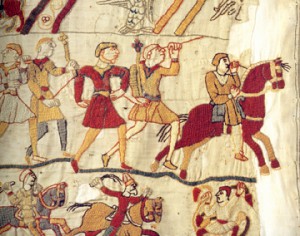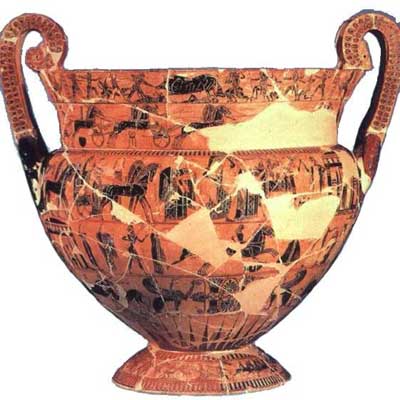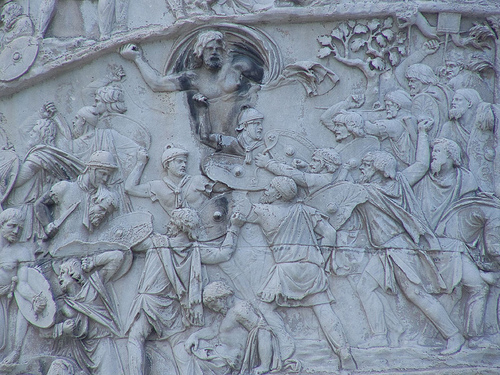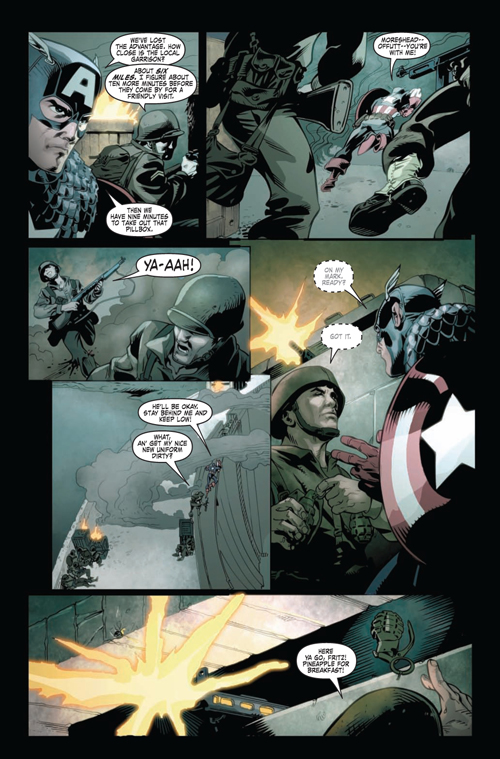
Detail of the Bayeux Tapestry,c.1066. People eat, sleep, breed and create.
In this post I will quickly address to a specific example and a specific theory that goes into this subject. Even though we do not see art as a necessity to life, as long as we life there tends to be creativity. Apparently they go together, they feed each other. How are they linked? Besides sleeping, eating and breeding, do we need culture? If it does not contribute to surviving, why is it there? Man has been carving in caves, painting in sand and weaving threads to tell stories that will survive us. You could say this is a pattern in human existence. If storytelling or archiving in either books or objects is a pattern, is creation equal to basic need? Researching this subject I found the Bayeux Tapestry to be a nice study case. Tapestry’s made at the time of the Bayeux Tapestry are often described as folk art. Folk art, a concept that is very well explained by Jean Dubuffet, typically embodies traditional forms and social values. It originally suggested crafts and decorative skills associated with peasant communities in Europe – though presumably it could equally apply to any indigenous culture. It has broadened to include any product of practical craftsmanship and decorative skill. Folk art has also a utilitarian characteristic to it. Utilitarian because it displays the life events of a collective, rather than an individual experience. This social or collective aspect of it makes it interesting to research in association to social behavior. When looking at cultural history there are bluntly put two ways to look at the history: through folklore culture and through ‘elite’ art culture.
Art in the 14th century was a male dominated field. Artists worked a lot for commissions, and painting can be seen as the biggest medium. It represents an elite culture because the elite financed most paintings. On the opposite the folklore culture deals with a great collective history. Woman, left on the shores while their man went out for wars or exploration, stood together and shared their lives in many ways. It is no wonder then, that most of the folklore art, made by these women in particularly, is usually subject to a specific event in their lives. The documentation we know nowadays, is the same as the folk art way of storytelling of these long last centuries.




Greec Vase 570 BC, Trajan Column Rome, Captain America vs the Axis of Evil, a message from the Minestry of Homeland Security.
Although you could argue that the Bayeux Tapestry is not an example of folk art, I would say it is. It is true that the tapestry was made as a commission and the ‘team’ of people who made it where highly classified workers who were selected to work for the state of England. But think about it. It is not about who made it that much, it is about the specific choice for this medium. Each medium talks and feeds our minds differently, not only visually. So the English King and Queen wanted to document this period of Great War. They could also have chosen any other medium besides tapestry. They could get a painter to make a huge war scene; they could pick a hero from the battlefield and give him a statue. But they chose for the medium of textiles. And there is a reason for this choice. The Bayeux Tapestry is made in this form so that the people could relate to it. It is made as a form of propaganda to underline connections between the English crown and the bishop at the time in England. Also there are small references to the Normandy regime, undermining their power and choosing a more heroic English version of the battlefield. The Bayeux Tapestry, or actually the real technique is embroidery, is like a modern propaganda youTube movie. Looking at it shows no difference to ‘real’ amature paste-up movies. In this case there is surely a strategy behind it. I do not want to go into this too much, or make it a conspiracy story, but it seems not more than logical to me that a mass medium is not always just directing the masses of the people. It can also be used to address the elite, because it appeals so much to the mass. Susan Sontag already wrote it in on photography. Amateur pictures and art photography are different. They talk different. But this difference is a strength you can use.
So from which desire does folk art come?  In researching the essence of why we create the basic question first is what is there to create from? Philosophers have written many theories about how we perceive the world. Choosing one of the many, I focus on the theory of Lacan. It describes three ways in which the world is ordered. It is interesting because it suggests that the way we life, think, and create are prior to eating, sleeping and breading. This all comes from Lacan’s theory on the three world orders, being the real, the symbolic and the imaginary.
In researching the essence of why we create the basic question first is what is there to create from? Philosophers have written many theories about how we perceive the world. Choosing one of the many, I focus on the theory of Lacan. It describes three ways in which the world is ordered. It is interesting because it suggests that the way we life, think, and create are prior to eating, sleeping and breading. This all comes from Lacan’s theory on the three world orders, being the real, the symbolic and the imaginary.
Lacan’s order of the Real finds a lot of similarities with the well known philosophical term ‘die welt an sich’. The real order is the objective outside world, known as a whole, without any conceptual boundaries set by language. This order always remains invisible for the subject, never to grasp. The symbolic order is the world the way we experience it through language, image, story, and so on. Every conceptual possibility in words is used to give form to the imaginary order. That imaginary order is the world of desire and fantasy. It is not only desire and fantasy as we know it in de Freudian way.
In Lacan’s theory the imaginary refers to every single subjective experience through the real. In the three orders it is clear that the imaginary order is something that is fundamental to our being. We think, or at least we would like to believe so. Every thought, desire, fantasy or whatever you experience non-materialistically fits into this order. But it did not come there by a gift of god. Like I said above, the three orders feed each other. Our experience comes from the real world, but what we notice of this is depending on the symbolic order. In a way the symbolic order determines what we explore of this real order. Then again, the imaginary takes all these concepts deriving from the symbolic order into consideration and is able to give some output.
This output needs a concept, definition, or even materialization to be noticed and to be justified. And this is the point were culture comes in. From this I understand that culture is like a snowball. It takes along things that stick, it leaves out things that don’t. It starts small but picks up along the way and grows and grows and grows. When accepting this theory it is very logically that creation is a fundamental part of our existence, because we need concepts and objects to think. Without thinking we cannot react.
What for example the Bayeux Tapestry is showing us, is in a way nothing new to what we already know: we shape and create our own existence. This does not come after the first basic surviving needs of eating sleeping breading etc; it goes parallel next to it.



